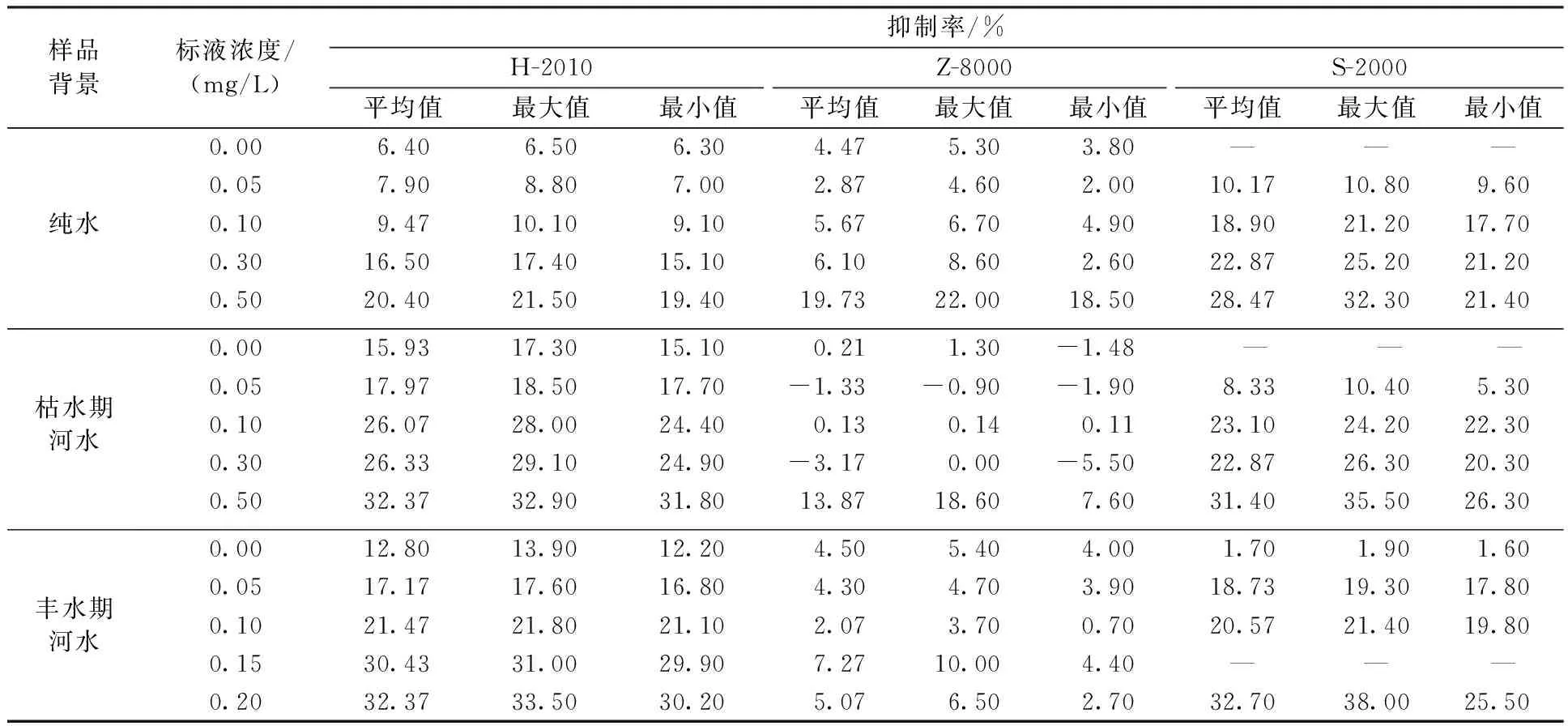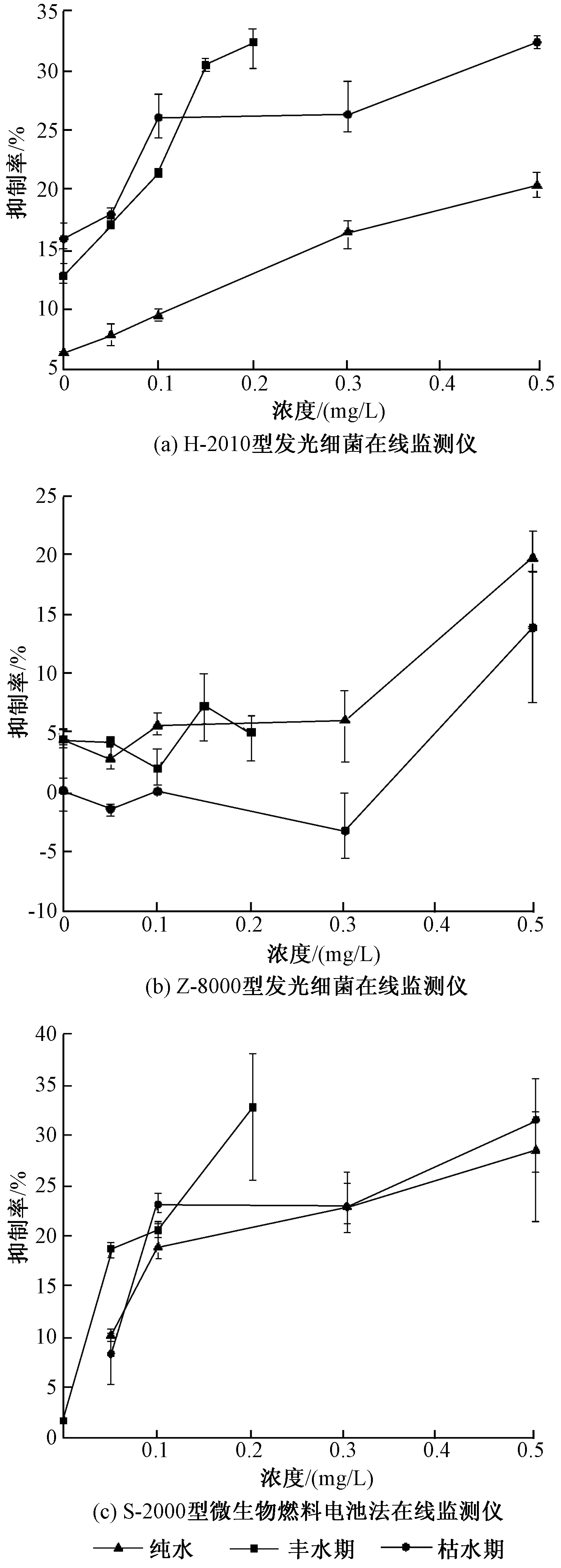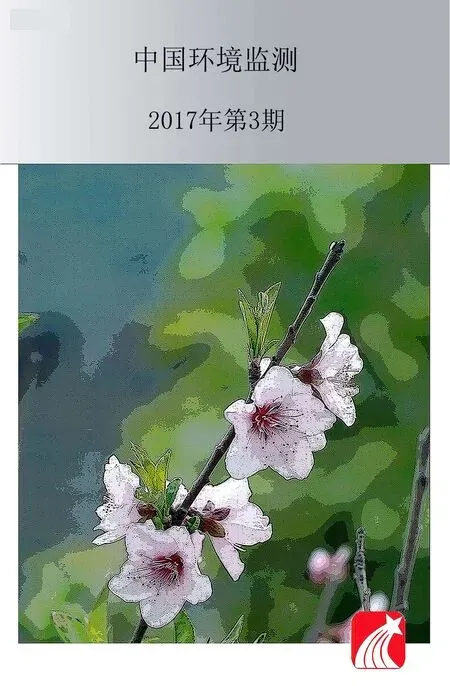As水质毒性发光细菌及微生物燃料电池在线监测技术的比选研究
易 雯, 严惠华, 林秀榕, 张 琳, 韩士松, 王仕琦
广东省环境监测中心,广东 广州 510308
As水质毒性发光细菌及微生物燃料电池在线监测技术的比选研究
易 雯, 严惠华, 林秀榕, 张 琳, 韩士松, 王仕琦
广东省环境监测中心,广东 广州 510308
针对实际应用需要,对比研究了发光细菌和微生物燃料电池两种不同毒性预警技术对典型类金属砷离子的响应差异,并考察了丰水期、枯水期河水水质背景干扰对响应信号的影响。结果表明,发光细菌法对砷离子响应较为灵敏,微生物燃料电池法对砷离子的响应非常灵敏。发光细菌法受水体水质背景干扰大,且不同生产厂家的仪器差异显著,推测可能是由于菌株来源不同、仪器响应灵敏度差异所造成。微生物燃料电池法对背景干扰的抗性较强,稳定性较高,河水加标与纯水加标样本的剂量-效应曲线差别不大。基于上述研究结果,分析了两种技术监测类金属砷的优缺点并提出实际在线运行的相关建议。
砷;发光细菌;微生物燃料电池;生物监测
Abstract:Research of the two biomonitoring technologies were conducted for the needs of their practical applications. The comparison between their response differences to arsenic ions as well as the effects of matrix interferences of the river water in the wet and dry seasons on the responses were presented. The study found that the luminescent bacteria toxicity test is sensitive to the arsenic ions; however, still being inferior to the microbial fuel cells toxicity methods. The toxicity test based on the luminescent bacteria is easy to be interfered by water background. The online instruments from the different manufacturers showed different response signals to the toxicant at the same concentration. We speculated that the difference in the sources of bacterial strain and the sensitivities of instruments led to the different response signals. In practical, the microbial fuel cells toxicity method was found with advantages such as good anti-interference ability and high stability. Based on the abovementioned results, the advantages and disadvantages of the two technologies have been concluded and some recommendations were given for their practical on-line operation.
Keywords:arsenic;luminescent bacteria;microbial fuel cell;bio-monitoring
发光细菌法是利用一类能够发射可见荧光,且发光量的强弱程度与其活体数量和代谢活性有关的细菌建立的一种生物毒性在线监测方法。当水体受到污染时,会导致发光细菌代谢活性受到抑制甚至死亡,发光强度减弱。污染越严重,发光细菌代谢活性抑制越强、死亡数量越多,发光强度也越弱,从而可以判断水质的综合毒性。目前,国内常用的3种发光细菌为明亮发光杆菌(PhotobacteriumphosphoreumT3spp)[10]、费氏弧菌(Vibriofischeri)[11]、青海弧菌(Vibrioqinghaiensissp. nov , strain Q67)[12-14]。鉴于发光细菌法是一种快速、灵敏、经济的监测方法,现已广泛用于环境污染物综合毒性监测中[15-20]。
微生物燃料电池是以微生物为阳极催化剂,将化学能转化成电能的装置[21-24]。其原理是微生物直接将水中有机物分解产生电子,代谢过程中的电子转化成电流。当毒性物流入时,微生物活性降低,产生电流减少,利用电流强度与污染物浓度呈线性关系而建立生物毒性在线监测方法。该方法响应速度较快、重复性较好,国内外已有很多研究者用其开发水质毒性综合监测的传感器[25-30]。
本研究从实际应用需要出发,比较研究基于发光细菌和微生物燃料电池两种不同水质生物毒性在线监测技术对典型类金属砷的响应差异,探讨水体背景干扰对响应信号的影响,为水质生物毒性在线监测技术的规范化运行提供基础数据,服务于水质安全预警技术体系和监督检测体系的完善和业务化运行。
1 实验部分
1.1仪器与试剂
两种国产发光细菌水质毒性在线监测仪和进口微生物燃料电池水质毒性在线监测仪,仪器型号及使用情况见表1。

表1 仪器型号及使用情况
试剂和材料:含1%硝酸的砷标准品;容量瓶;移液管;洗耳球;酸缸;仪器维护耗材等。
1.2实验方法
取浓度为100 mg/L的As标准溶液10.00 mL于100 mL容量瓶,用纯水稀释定容浓度为10 mg/L的As标准中间使用液;吸取10 mg/L的As标准中间使用液5.00、10.00、30.00 mL各3组,吸取浓度为100 mg/L的As标准溶液5.00 mL 3组,分别用纯水、丰水期河水、枯水期河水稀释定容至1 000 mL,配制成As3+标准溶液浓度分别为0.05、0.1、0.3、0.5 mg/L的3种不同背景的测试样品(其中,丰水期河水背景As3+浓度为0.3、0.5 mg/L的测试样品按同样方法分别换成0.15、0.2 mg/L)。
赵某散步时和刘某家的狗迎面相遇,刘某的狗突然蹿至赵某身后咬了一口,事后,赵某经就医治疗共花费数千元。经过民警调解,双方未达成一致意见,故赵某将刘某诉至法院,要求其赔偿医疗费等各项费用共计3000余元。
考察两种水质生物毒性在线监测技术(3台仪器)对砷离子的信号响应,每种水样测试3次,以抑制率平均值和极差表征实验结果。
2 结果与讨论
2.1纯水背景下两种在线监测技术对类金属砷的毒性响应对比
两种水质毒性在线监测技术对砷离子毒性效应的比较如图1所示。以费氏弧菌为菌株的两种生物毒性在线监测仪器数据取平均值,与微生物燃料电池法水质毒性在线监测仪器数据进行对比。

图1 两种水质毒性在线监测技术对不同浓度砷的毒性效应(均值-极差)Fig.1 The toxicity effects of two different toxicity on-line monitoring technologies of water quality on different concentrations of arsenic (average-range)
从图1可以看出,在实验室纯水配水状态下,两种技术对砷的响应都比较灵敏。高浓度条件下(浓度大于等于0.5 mg/L),微生物燃料电池法的响应灵敏度与发光细菌法相当,在低浓度情况下明显优于发光细菌法(浓度小于等于0.1 mg/L)。总体上,微生物燃料电池法较发光细菌法更为灵敏。
2.2河水背景下两种在线监测技术对类金属砷的毒性响应对比
分别以广东省韶关乐昌三溪水站枯水期、丰水期河水为背景基质进行两种技术的对比,河水水质基本理化参数如表2所示。可以看出,由于该水站上游存在大量有色金属矿,水体本底金属离子含量较高,其中砷、锑、镉3种金属在丰水期接近或超过《地表水环境质量标准》(GB 3838—2002) III类水质标准限值。
比较两种在线监测技术对不同浓度砷离子河水加标样本的信号与纯水加标样本的信号,表3、图2为抑制率响应对比的情况。

表2 枯水期和丰水期河水水质参数
注:“*”表示《地表水环境质量标准》(GB 3838—2002)中基本项目III类水质标准限值或特定项目标准限值; “—”表示未测试或无相关要求;“ND”表示未检出。

表3 不同水质毒性在线监测技术在河水背景和纯水背景下对不同浓度砷的毒性响应
注:“—”表示未测试。
如图2(a)所示,H公司生产的H-2010型发光细菌法水质毒性在线监测仪在河水背景下与纯水背景相比,抑制信号呈增强趋势,增强百分比为58.7%~175.3%。图2(b)中,Z公司生产的Z-8000型发光细菌法水质毒性在线监测仪在河水背景下则呈现出相反的抑制信号减弱趋势,与纯水背景相比,抑制信号减弱29.7%~152.0%。此外,从图2(a)和图2(b)中可以看出,两种发光菌法水质毒性在线监测仪在纯水背景下砷的水质毒性剂量-效应关系有较好的一致性,这是第2.1小节中以费氏弧菌为菌株的生物毒性在线监测仪器数据取平均值的基础,也是本小节中两种发光细菌法水质毒性在线监测仪在河水背景与纯水背景下对砷水质毒性响应比较的基础,从而进一步说明以费氏弧菌为菌株的发光细菌生物毒性在线监测仪数据在丰水期和枯水期两种河水背景下的响应信号与纯水背景样本相比均有较大差异,不同厂家仪器灵敏度差异显著。

图2 不同水质毒性在线监测技术在河水背景和纯水背景下对不同浓度砷的毒性响应Fig.2 The toxicity effects of different toxicity on-line monitoring technologies of water quality on different concentrations of arsenic in the background of river and pure water
图2(c)中,国外某公司生产的S-2000型微生物燃料电池法水质毒性在线监测仪则表现出较好的稳定性,河水背景与纯水背景样本的抑制响应曲线差别不大,除在丰水期河水背景下,砷离子浓度为0.05 mg/L时与纯水背景相比数据波动较大外,枯水期数据和砷离子浓度为0.1 mg/L,丰水期数据与纯水背景相比波动仅在0~22.2%范围变化。
根据文献报道,由于河水背景中的营养物质和盐分等因素,发光细菌的代谢加速,发光强度与纯水相比会增强[31-32],从而导致抑制信号减弱;另外,河水背景中仍然存在一些微量重金属,加入砷后有可能会产生联合毒性效应,从而抑制信号增强。推测图2(a)中在河水背景下抑制信号增强是由于该公司发光细菌菌种对重金属的毒性效应响应比较灵敏,河水中存在的其他重金属的毒性效应也表现出来,增强了抑制信号。图2(b)中在河水背景下抑制信号减弱推测是由于该公司发光细菌菌种对重金属的毒性效应响应灵敏度一般,发光细菌在河水中的发光强度增强占了主导作用。综上所述,发光细菌法受水体背景干扰大,不同生产厂家仪器测试的毒性效应差异显著。而微生物燃料电池法抗背景干扰能力强,有较强的稳定性。
2.3对两种生物毒性在线监测仪的运行建议
发光细菌法水质生物毒性在线监测技术受实际水样的背景信号影响大,建议实际运行时结合灵敏度需要用河水做标线,建立该背景基质条件下的剂量-效应曲线,必要时可依此扣除背景基质影响修正报警阈值。发光细菌法的不同设备厂家在线监测仪器的信号差异显著,推测是由于菌株来源不同、菌液浓度差异和仪器响应灵敏度不同所造成。因此,在后续规范化运行中,建议规范菌株来源,建立相应的仪器标准和方法标准,以使仪器之间数据具有可比性和参考价值。
微生物燃料电池法水质生物毒性在线监测技术的缺点是微生物中毒后修复时间较长,建议在设备中专门设置微生物培养罐,解决微生物被驯化和中毒后修复时间长的问题。
3 结论
发光细菌法水质生物毒性在线监测技术对类金属砷较为灵敏,但发光细菌法受水体背景干扰大,且不同生产厂家仪器的毒性效应差异显著。
微生物燃料电池法水质生物毒性在线监测技术对类金属砷的响应灵敏度高,且响应信号受实际样品背景干扰小,稳定性高,河水加标与纯水加标样本的毒性响应曲线差别不大。
两种方法都有其优势与不足,因技术方法不同或相同方法使用不同厂家的菌种和仪器,造成同一浓度有毒物质产生的毒性效应有所差异。实际应用于河流水污染毒性测试时应根据所需监测的毒性物质、时间、成本等因素综合比选技术方法与仪器设备。
[ 1] 彭强辉,陈明强,蔡强,等. 水质生物毒性在线监测技术研究进展[J].环境监测管理与技术, 2009, 21(4):12-16.
PENG Qianghui, CHEN Mingqiang, CAI Qiang, et al. Research development of on-line toxicity bio-monitoringtechnique of water quality[J]. Environ-mental Monitoring Management and Technology,2009, 21(4):12-16.
[ 2] 邹曦,万成炎,潘晓洁,等.水环境在线生物监测的研究与应用[J]. 环境科学与技术, 2011, 34(12H):155-159.
ZOU Xi, WAN Chengyan, PAN Xiaojie,et al.Study and application of on-line biological monitoring systemin water environment[J].Environmental Science&Technology,2011, 34(12H):155-159.
[ 3] 司镪,武丹,王海英. 水质生物毒性在线监测的必要性和常用方法探讨[J].绿色科技,2013(4):205-207.
SI Qiang, WU Dan, WANG Haiying. Necessity of online monitoring water biotoxicity and related common methods[J].Journal of Green Science and Technology, 2013(4):205-207.
[ 4] 于春来,卢振兰,王洪平,等.生物监测及其在线监测在水环境污染中的应用[J].北方环境, 2011,23(1/2):144-145.
YU Chunlai, LU Zhenlan, WANG Hongping, et al.Application of biomonitoring technique in pollution of aquatic environment[J]. Northern Environment, 2011,23(1/2):144-145.
[ 5] 刘允,解鑫. 水体生物毒性检测技术研究进展综述[J].净水技术, 2013, 32(5):5-10.
LIU Yun, XIE Xin. An overview of research advances in biological toxicity detection technology for water environment[J]. Water Purification Technology,2013, 32(5):5-10.
[ 6]KIM M, HYUN M S, GADD G M, et al. A novel biomonitoring system using microbial fuel cells[J]. Journal of Environmental Monitoring, 2007,9(12):1 323-1 328.
[ 7] APPELS J, KAZLAUSKAITE L, RIBO J, et al. Evaluation of an automated luminescent bacteria assay for in situ aquatic toxicity determination[J]. Science of the Total Environment, 2012(440):307-313.
[ 8] WATSON S B, JUTTNER F, KOSTER O. Daphnia behavioural responses to taste and odour compounds:ecological significance and application as an inline treatment plant monitoring tool[J]. Water Science and Technology, 2007,55(5):23-31.
[ 9] GREEN U, KREMER J H, ZILLMER M, et al. Detection of chemical threat agents in drinking water by an early warning real-time biomonitor[J]. Environ Toxicol, 2003,18(6):368-374.
[10] KIM B C, GU M B. A multi-channel continuous water toxicity monitoring system:its evaluation and application to water discharged from a power plant[J]. Environmental Monitoring and Assessment, 2005,109(1/3):123-133.
[11] SCHOUEST K, ZITOVA A, SPILLANE C, et al. Toxicological assessment of chemicals using caenor-habditis elegans and optical oxygen respirometry[J]. Environmental Toxicology and Chemistry, 2009,28(4):791-799.
[12] 贺志庆,王文波. 发光细菌的特性及其在环境监测方面的应用[J].化学工程与装备,2008(2):105-106.
HE Zhiqing, WANG Wenbo. Characteristics of luminescent bacteria and its application in environmental monitoring[J]. Chemical Engineering & Equipment, 2008(2):105-106.
[13] 崔晓.浅谈发光微生物[J].科技信息,2008,18:322- 323.
CUI Xiao. A review on luminescent bacteria[J].Science&Technology Information,2008,18:322-323.
[14] 朱文杰,汪杰,陈晓耘,等. 发光细菌一新种-青海弧菌[J].海洋与湖泊, 1994, 25(3):273-279.
ZHU Wenjie, WANG Jie, CHEN Xiaoyun, et al. A new species of luminous bacteriavibrioqinghaiensissp. nov[J]. Oceanologia et Limnologia Sinica,1994, 25(3):273-279.
[15] 高继军,张力平,马梅.应用淡水发光菌研究二元重金属混合物的联合毒性[J].上海环境科学, 2003, 22(11):772- 775.
GAO Jijun, ZHANG Liping, MA Mei. Study on combined toxicity of binary mixture of heavy metals by applying freshwater luminescent bacteria vibrio qinghaiensis-Q67[J]. Shanghai Environmental Sciences,2003, 22(11):772-775.
[16] FULLADOSA E, MURAT J C, VILLAESCUSA I. Study on the toxicity of binary equitoxic mixtures of metals using the luminescent bacteria Vibrio fischeri as a biological target[J]. Chemosphere, 2005, 58(5):551-557.
[17] GU M B, MIN J, KIM E J. Toxicity monitoring and classification of endocrine disrupting chemicals (EDCs) using recombinant bioluminescent bacteria[J]. Chemosphere, 2002, 46(2):289-294.
[18] HAKKILA K, MAKSIMOW M, KARP M, et al. Reporter genes lucFF, luxCDABE, gfp, and dsred have different characteristics in whole-cell bacterial sensors[J]. Anal Biochem, 2002,301(2):235-242.
[19] IVASK A, GREEN T, POLYAK B, et al. Fibre-optic bacterial biosensors and their application for the analysis of bioavailable Hg and As in soils and sediments from Aznalcollar mining area in Spain[J]. Biosensors & bioelectronics, 2007,22(7):1 396-1 402.
[20] GE H L, LIU S S, SU B X, et al. Predicting synergistic toxicity of heavy metals and ionic liquids on photobacterium Q67[J]. Journal of hazardous materials, 2014,268:77-83.
[21] ZHANG J, LI J, YE D D,et al. Tubular bamboo charcoal for anode in microbial fuel cells[J]. Journal of Power Sources, 2014,272:277-282.
[22] CHANG I S, JANG J K, GIL G C, et al. Continuous determination of biochemical oxygen demand using microbial fuel cell type biosensor[J]. Biosensors & bioelectronics, 2004,19(6):607-613.
[23] RITTMANN B E, KRAJMALNIK-BROWN R, HALDEN R U. Pre-genomic, genomic and post-genomic study of microbial communities involved in bioenergy[J]. Nature reviews Microbiology, 2008,6(8):604-612.
[24] RABAEY K, VERSTRAETE W. Microbial fuel cells: novel biotechnology for energy generation[J]. Trends in biotechnology, 2005,23(6):291-298.
[25] 吴锋,刘志,周奔,等. 单室MFC型生物毒性传感器对重金属离子的检测研究[J].环境科学, 2010, 31(7):1 596-1 600.
WU Feng, LIU Zhi, ZHOU Ben, et al. Development of a low-cost single chamber microbial fuel cell type BOD sensor[J].Environmental Science,2010, 31(7):1 596-1 600.
[26] RASMUSSEN M, MINTEER S D. Long-term arsenic monitoring with an Enterobacter cloacae microbial fuel cell[J]. Bioelectrochemistry. 2015,106:207-212.
[27] KIM M, YOUN S M, SHIN S H, et al. Practical field application ofa novel BOD monitoring system[J]. Journal of Environmental Monitoring, 2003, 5(4):640-643.
[28] MOON H, CHANG I S, JANG J K, et al. On-line monitoring of low biochemical oxygen demand through continuous operation of amediator-less microbial fuel cell[J]. Journal of Microbiology and Biotechnology,2005, 15(1):192-196.
[29] LIU B, LEI Y, LI B. A batch-mode cube microbial fuel cell based "shock" biosensor for wastewater quality monitoring[J]. Biosensors & bioelectronics, 2014,62:308-314.
[30] LI Y, WU Y, LIU B, et al. Self-sustained reduction of multiple metals in a microbial fuel cell-microbial electrolysis cell hybrid system[J]. Bioresource technology, 2015,192:238-246.
[31] 马晓妍,闫志刚,刘永军,等.污水的青海弧菌Q67生物毒性检测及影响因素分析[J].环境科学, 2011, 32(6):1 632-1 637.
MA Xiaoyan, YAN Zhigang, LIU Yongjun, et al. Detection of wastewater ecotoxicity usingVirbrioqingh-aiensissp.-Q67 and its impact factors analysis[J].Environmental Science, 2011, 32(6):1 632-1 637.
[32] 郭重华,钱蜀,廖翀,等.生物发光菌技术在地震灾区饮用水源地水质监测中的应用[J].地质灾害与环境保护, 2010, 21(1):109-112.
GUO Zhonghua, QIAN Shu, LIAO Chong, et al. Application of luminescent bacteria biologicaltoxicity test technology to monitoring the drinkingwater quality in the earthquake-stricken area[J].Journal of Geological Hazards and Environment Preservation, 2010, 21(1):109-112.
[33] 魏中华,徐娟,郭明霞,等.国内多菌灵的研究进展[J].安徽农业科学, 2015, 43(3):125-127, 141.
WEI Zhonghua, XU Juan, GUO Mingxia, et al. Research progress of carbendazim in China[J].Journal of Anhui Agricultral Science, 2015, 43(3):125-127, 141.
ComparisonResearchonTwoOn-lineBio-monitoringTechnologiesBasedonLuminescentBacteriaandMicrobialFuelCellsfortheWaterQualityToxicityofAs
YI Wen, YAN Huihua, LIN Xiurong, ZHANG Lin, HAN Shisong, WANG Shiqi
Guangdong Environmental Monitoring Centre, Guangzhou 510308,China
X830.2
A
1002-6002(2017)03- 0133- 06
10.19316/j.issn.1002-6002.2017.03.20
2016-06-01;
2017-03-02
中央重金属污染防治资金项目“北江流域饮用水源水质安全监控预警关键技术研究与系统平台建设”
易 雯(1963-),女,湖南怀化人,教授级高级工程师。

